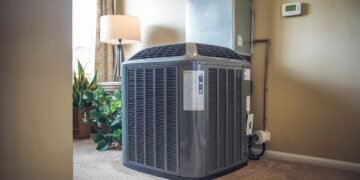When it comes to choosing the right HVAC company in Mount Airy MD, understanding the intricacies of HVAC systems is crucial. One term that often comes up in this context is SEER or Seasonal Energy Efficiency Ratio. But what exactly is SEER, and why does it matter when selecting an HVAC system for your home or business? In this comprehensive guide, we will delve deep into the world of SEER and explore its significance in the realm of heating, ventilation, and air conditioning.
What Is SEER?
Seasonal Energy Efficiency Ratio (SEER) is a critical metric that quantifies the energy efficiency of air conditioning systems. It measures the cooling a system provides per unit of energy consumed, acting as an indicator of its performance. In simple terms, SEER is to your air conditioner what miles-per-gallon (MPG) is to your car; a higher SEER rating, like higher MPG, indicates better energy efficiency.
The formula for calculating SEER is:
SEER= Total Cooling Output (BTUs) / Total Electric Energy Input (watt-hours)
SEER provides a snapshot of an HVAC system’s efficiency over an entire cooling season, taking into account variations in temperature and humidity. Ratings can vary, typically ranging from 13 for less efficient systems, to over 20 for the most efficient ones.
The actual efficiency and energy savings of a system with a particular SEER rating will depend on various factors including the climate of the region, system sizing, and usage patterns. In hotter climates with longer cooling seasons, a higher SEER rating is more beneficial due to the greater energy savings over time, potentially offsetting the higher initial costs of more efficient systems.
Why Does SEER Matter?
Energy Savings
A higher SEER rating denotes greater energy efficiency, which translates to lower utility bills and optimized system performance. This efficiency reduces energy wastage and the need for frequent maintenance, contributing to significant savings, especially in peak seasons.
Environmental Impact
High SEER HVAC systems consume less power, resulting in lower greenhouse gas emissions and reduced demand on electricity grids. Choosing a system with a high SEER rating is an environmentally conscious decision that contributes to sustainability and minimizes ecological footprints.
Enhanced Comfort
HVAC systems with higher SEER ratings offer consistent temperatures across different rooms and improved air quality through advanced filtration technologies. These features ensure a comfortable indoor environment, especially in extreme weather conditions, by reducing pollutants, allergens, and dust.
Long-Term Investment
Investing in a high SEER system brings durability, reliability, and potentially higher resale values for properties. These systems are often designed with advanced technologies and quality components, resulting in fewer breakdowns and longer lifespans, proving advantageous for property value.
How to Determine the Right SEER Rating?
Determining the right SEER rating for your HVAC system requires a careful balance of several factors, including climate considerations, budgetary constraints, long-term goals, and the availability of rebates and incentives. Here’s how to navigate through these considerations.
Climate Considerations
Regional Variations: The climate of your region significantly impacts the ideal SEER rating. In hotter, more humid climates, a higher SEER rating is beneficial as it offers more efficiency during longer cooling seasons.
Usage Patterns: Consider your specific cooling needs and usage patterns. If you use air conditioning extensively, investing in a higher SEER rating can lead to more savings in the long run.
Budgetary Constraints
Initial Investment vs. Long-Term Savings: Higher SEER ratings generally come with higher upfront costs. Assess your budget and weigh the initial investment against the potential long-term energy savings and reduced operational costs.
Cost-Benefit Analysis: Conduct a thorough cost-benefit analysis to determine whether the additional investment in a higher SEER rating is justified by the anticipated savings on energy bills.
Sustainability Objectives
If environmental sustainability is a priority, a higher SEER rating aligns with reduced energy consumption and a smaller carbon footprint.
Property Value: Consider the impact on property value. Energy-efficient homes with higher SEER HVAC systems are often more appealing to buyers, potentially increasing resale value.
Rebates and Incentives
Local and Federal Incentives: Explore available local, state, and federal rebates and incentives for energy-efficient appliances. These incentives can significantly offset the initial cost of higher SEER HVAC systems.
Utility Company Programs: Some utility HVAC Mount Airy companies offer programs or discounts for installing energy-efficient appliances. Check with your local utility provider to see if such programs are available in your area.
SEER Ratings Demystified
SEER 13-14: Minimum efficiency for moderate climates.
SEER 15-16: Mid-tier efficiency, suitable for hotter climates.
SEER 17-20: High efficiency, ideal for extreme conditions and long-term investment.
SEER 21 and Above: Ultra-efficiency, for those prioritizing environmental impact and long-term savings.
Common Misconceptions About SEER
a) Higher SEER Always Means Better: Higher SEER is beneficial, but it’s essential to consider climate and usage.
b) All HVAC Systems Are Created Equal: Variability in design and technology affects performance.
c) SEER Is the Only Important Factor: Other factors like size and installation quality matter.
d) Upgrading Always Saves Money: Savings depend on usage, climate, and existing system efficiency.
Wrapping Up
In conclusion, SEER is a vital factor in choosing HVAC systems. Understanding SEER ratings, addressing common misconceptions, and balancing various considerations help in making informed decisions. When selecting an HVAC company in Mount Airy MD, ensure they offer professional guidance to navigate the complexities of SEER and choose a system that aligns with your needs, preferences, and environmental consciousness.
Recommended Posts:















